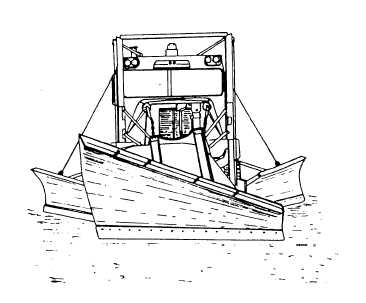Plows
The plow is the most commonly used in snow
removal operations. Push plows are commonly referred
to as blades because of their different configurations.
Three types of snow plow blades are the reversible,
rollover, and combination.
REVERSIBLE BLADE.— A reversible blade (fig.
14-38) is a snowplow blade that can be positioned to
bulldoze snow straight ahead or angled to throw snow
to the right or left. This is a smaller type of blade and is
generally mounted on light trucks.
Reversible plows are most efficient for clean-up
work or for use in restricted areas where you desire to
change the angle of the blade, rather than dead ahead.
These plows are also good for removing light snow from
roads, walks, platforms, and storage areas. Reversible
plows are intended for slow-speed operation and will
not remove snow as effectively as other plows; however,
they can be used to plow airfield pavements, even if they
move less snow than other plows.
ROLL-OVER BLADE.— A roll-over blade (fig.
14-39) can plow snow to either side. It has a tapered
moldboard, formed to give snow a lifting, rolling action
and can throw snow a considerable distance at fairly
high speeds. To change from right to left, raise the plow
as high as it can go and (as the name implies) roll the
plow over. The toe will remain at the bottom of the arc,
and the heel will be the top of the arc.
NOTE: Come to a complete stop to prevent
damaging the plow when rolling the blade over.
There is only a few inches of clearance when the
blade passes the center.
After you roll the blade over
and before you begin another pass, return the blade hoist
lever to the float position to allow the plow to follow the
contour of the pavement.
Figure 14-38.—Reversible blade.
Figure 14-39.—Roll-over blade.
The maximum speed at which snow removal
equipment is allowed to operate varies with each
military installation.
Whenever possible, you should
drive a roll-over snowplow 20 to 30 miles per hour
(mph) to get good action off the end of the blade. If you
drop the speed down to less than 20 mph, the snow does
not have enough rolling action when it comes off the end
of the blade, resulting in a high windrow.
On the other hand, if you maintain a speed of 20 mph
or more, the snow will be thrown off the end of the blade
and be scattered thinly. When plowing windrows with a
roll-over plow or a reversible or a combination blade, you
can keep your speed up by taking less than a full blade of
snow or by drifting out of the windrow until you regain
your speed and then pulling back into the windrow.
COMBINATION BLADE.— A combination
blade (fig. 14-40) can be used in either of three of the
following positions:
Figure 14-40.—Combination blade.
14-33





